The soldiers of the US Army’s 1st Battalion of the 506th Infantry Regiment, Ghazni, Afghanistan, keep a close eye on their stretch of a vital road linking Kabul and Kandahar. Earlier last year, they began coming across unusual roadside bombs.
The bombs contained 200 to 500 pounds of explosives, much more than any seen before. Moreover, insurgents had planted them in culverts running beneath the highway, where they were hard to see. The bombs proved to be devastating to trucks and the new Mine Resistant, Ambush Protected vehicle, or MRAP.
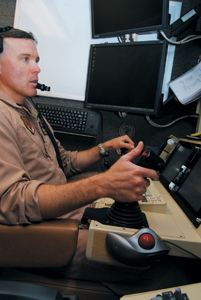 |
Maj. John Chesser at the pilot’s control station for an MQ-9 Reaper at Joint Base Balad, Iraq. |
Yet, fortunately, US forces had a breakthrough against this threat. Air Force MQ-1 Predator unmanned reconnaissance aircraft and the airmen who were flying them helped break up the bomb teams and greatly reduce large-scale bomb attacks along the highway. With the help of full-motion video from the MQ-1s, the battalion (part of the 101st Airborne Division) needed only seven days to find and eliminate five Taliban cells attempting to plant these improvised explosive devices, or IEDs.
Moreover, Predator reconnaissance and strike capabilities helped the battalion strike and kill a team of IED planters sent from Pakistan to train Afghan recruits. At the site of one Predator strike, US troops discovered Pakistani currency and ID cards.
There is still a risk that such teams will return to plant bombs along the highway, which, intact, is a key symbol of progress in war-torn Afghanistan. As it stands now, while on patrol between bases, US troops get out of their vehicles to check every culvert along the highway. There are some 1,000 such culverts on this road, however, and keeping all of them clear in this manner is unrealistic.
For this reason, battalion officials would like to see more unmanned aerial vehicles, to help them determine patterns of activity along the highway. And that, demonstrated by one battalion on one front of the War on Terror, is an explanation for the US military’s insatiable demand for UAVs.
The Air Force is launching a number of new measures to expand UAV capabilities in response to the ever-growing demand for Predator, MQ-9 Reaper, and other unmanned systems. In a series of firsts, freshly minted pilots are being sent directly to UAVs for their initial assignments, nonpilots are being trained as unmanned aircraft pilots, and UAV operators will soon have their own distinct career field.
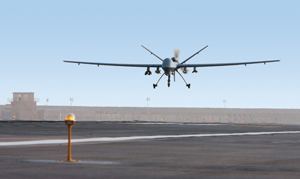 |
A Reaper on an Operation Enduring Freedom mission in Afghanistan |
By 2012, the Air Force plans to increase the ranks of UAV pilots and air operations staffers to a total of 1,100. That is up from just over 450 Predator and Reaper operators today—and 180 just a couple of years ago.
Such an increase, notes Brig. Gen. Lyn D. Sherlock, director of air operations for the Air Staff’s directorate of operations, will make the size of the UAV pilot community second only to that of the F-16.
It is a change that has been long in coming. The Air Force “must promote a strong and healthy [UAV] community, not a ‘leper colony’ or an agency of expedience,” said Gen. Norton A. Schwartz, Air Force Chief of Staff, in announcing the change in September.
The buildup is an acknowledgement that UAVs and the pilots who fly them are going to be in critical demand in the years to come.
Much of the drive for more pilots stems from the problems caused by rising violence in Afghanistan and the relatively small contingent of US troops on the ground there. Those factors have created what currently amounts to overwhelming demand, said Col. Trey Turner, commander of the 451st Air Expeditionary Group in southern Afghanistan.
Predator and Reaper are vitally important to ground commanders for their integrated sensor balls and ability to stream video in near-real time to troops fighting militant groups throughout the country.
The UAVs help search the rough, mountainous terrain for insurgents and provide armed overwatch for troops in battle.
Of their numbers, “we could certainly use more,” said US Army Gen. David D. McKiernan, commander of all NATO forces in Afghanistan. “The border between Afghanistan and Pakistan runs 2,500 kilometers,” more than 1,500 miles. “That’s a huge area to maintain surveillance on.”
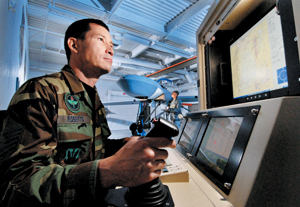 |
MSgt. Fred Roberts (foreground) and SSgt. Alex Bush (back) perform a check of an MQ-1 UAV system at March ARB, Calif. |
Beta Testing Begins
A multipronged approach will bolster the ranks of Predator and Reaper operators, Air Force officials say. “We want to go to a dedicated career field because we can see this as a force that we’re going to need in the future,” said Sherlock, “not only at the tactical, but at the operational and strategic [level].”
This realization has begun to affect the approach to the problem taken by the Air Force’s senior leadership. Indeed, until recently, USAF was recruiting specialized pilots (trained to fly F-16s, for example) for three-year UAV assignments involving a permanent change of duty stations.
A key initiative announced this fall, however, will create a cadre of pilots to fly UAVs exclusively.
To do this, the Air Force will send 10 percent of its undergraduate pilots directly to UAV training. The first class began a four-week fundamentals course Nov. 21 at Randolph AFB, Tex., before moving to Creech AFB, Nev., for more instruction. Each year, roughly 100 brand-new pilots will head down the UAV track.
This month, the Air Force will also begin beta testing a class of 10 active duty officers (up through the rank of captain) from various technical and nontechnical fields, to see if it can teach them how to fly armed UAVs. In the past, the Air Force has used only rated officers for this purpose.
If it succeeds, the program will give these trainees the green light to operate Predators and Reapers in national airspace and in battlefield conditions.
There has been a great deal of interest in such programs. “We want to look at someone who can learn to operate an unmanned system and teach them how,” said Sherlock. For that reason, the Air Force does not want beta testers “to even have a private pilot’s license,” she added. That’s because the Air Force wants to gauge the extent to which it can train to a new skill set.
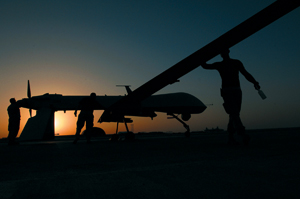 |
Airmen run a preflight inspection on an MQ-1 Predator UAV at Ali Base, Iraq. As the UAV fleet continues to grow, USAF will more than double its UAV pilot inventory. (USAF photo by A1C Jonathan Snyder) |
“In the beta test, we want to be able to show that we can take someone through an Air Force training program and teach him how to get air sense, and to fly in the United States as well as in a combat zone,” she said. “We want to make sure that the test is good for someone who has little or no aviation experience right now.”
Sherlock went on, “We found out that there are a lot of people interested.” Through October, the Air Force had received more than 700 inquiries. The initial “call out” for nonpilot UAV operators went only to airmen, because they understand Air Force culture. Not all of the applicants fit the criteria for the program, which is being designed for candidates with three to five years of experience.
Candidates will be screened for many of the same skill sets that traditional pilots need, including motor skills and vision. Though the eyesight requirements won’t be as stringent as they are for fighter pilots, color vision will still be important, said Sherlock.
Certain personality traits will also be vital, Sherlock added, among them decision-making capability under stress. After cutting the initial class of volunteers down to fewer than 40, the candidates will undergo physicals and then go through initial flight screening in Pueblo, Colo.
After a month, they too will go to Randolph Air Force Base and use simulators to learn instrument flying in the national airspace system. It is here the beta airmen will also learn about the UAV weapons, “and how that integrates into the fight,” said Sherlock.
Only then will the nontraditional pilots begin their training at Creech. The process will begin again for another 10 candidates this spring.
Plans call for Schwartz to decide later this year whether the program to train nonpilots will be institutionalized.
To create more UAV pilots, the Reaper schoolhouse at Creech added a second training line this past summer.
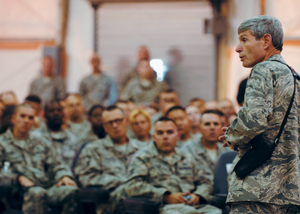 |
USAF Chief of Staff Gen. Norton Schwartz speaks about career field reorganization to airmen of the 447th Air Expeditionary Group at Sather AB, Iraq. In the past, all UAV pilots were reassigned from other aircraft. |
120 Days Straight
“That was a great expansion for us,” said Lt. Col. Christopher Gough, who directs the Reaper training program and leads the 42nd Attack Squadron. The schoolhouse has gone from training classes of seven or eight crews, to classes of 15 crews, “so we have effectively doubled the prior capacity. That has afforded us the opportunity to build what initially was a slow-to-mature system [because] we didn’t have enough people trained in it.”
The schoolhouse has also just entered into an agreement with a civilian contractor to take on academic work such as teaching engine and fuel system nuts-and-bolts. “We can focus our efforts on training and flying,” Gough explained.
Lt. Col. Lawrence Spinetta, commander of the 11th Reconnaissance Squadron and head of Creech’s MQ-1 schoolhouse, added, “Pilots are starting to realize that ‘unmanned’ is really a misnomer. There is a man in the loop every step of the way, including three men or women in the immediate crew.”
The fact that UAV pilots fly drones while sitting in high-tech trailers that are sometimes in and around Las Vegas creates some stereotypes, said Turner, commander of the 451st in Afghanistan.
“People think they’re smoking and joking in a casino somewhere,” he said.
However, he noted, it is very difficult to offer the UAV operators time off, and there is no time to release the pilots to the professional military education courses that are normally required.
At a base in southern Afghanistan, UAV pilots work 12 hours on and 12 hours off for 120 days straight, said Turner. “They don’t get days off the whole time they’re out here.”
That pace isn’t likely to let up anytime soon. The Air Force will probably buy “more unmanned than manned platforms next year,” Spinetta said, bumping Predator flying hours to 14,000 per month. “There’s no spin-up time.”
In the past, trainees would “graduate from a formal training unit, then spend a few months getting more seasoned, and do a Red Flag. Here, there’s none of that,” Spinetta said. “They graduate and 60 days later, they walk out the door and fly their first combat mission.”
Training for the crew therefore includes strict instructions on rules of engagement “and on when and how we employ ordnance,” said Spinetta.
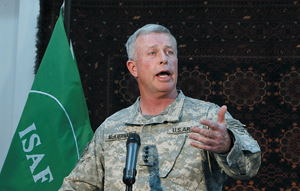 |
US Army Gen. David McKiernan, NATO commander in Afghanistan, speaks at a press conference in Kabul. McKiernan wants more UAVs in the theater. |
“We also get deep into who is able to provide that clearance authority, and how we coax that out of them,” Gough said. What’s more, the schoolhouse “works with guys on the ground to develop that awareness of friendly locations, and PID [positive identification], so that … we’re training with folks on the ground that mirror real-world scenarios.”
“These are going to be warriors capable of operating in the airborne environment,” said Sherlock. “So the expectation is that they will have the same skill sets and the same understanding of air battle operations, whether they’re operating a UAV or an aircraft.”
Sherlock noted, “All agree that, as we put them through training, as they engage in the fight, they will have the same culture and warrior skills” as traditional aviators.
“From the time I got my orders, it took me about a week to understand that this was going to be a game-changer, with a persistent stare and a persistent strike,” said Gough, who was an F-16 pilot before he took over the Reaper schoolhouse in 2008. “I’ve seen the future,” he said.
“The frustrating thing” about flying an F-16, he explained, is that the time in the air is limited. This is not a problem for long-flying UAVs. “Here, every day we’re putting the hurt on the bad guys. It’s relentless.”
The insurgents “have had the upper hand,” he said, because “they can wear civilian clothes and they can attack us.” The UAV, he said, “is leveraging technology, finding innovative ways to put the ball back in our court and seize the initiative. We can develop those patterns of life, determine who the bad guys are, and then get the clearance and go through the whole find, fix, track, target, attack cycle.”
Manned weapons systems simply do not offer the same persistence. With a Reaper, “I don’t have to go back and hit the tanker” and lose the uninterrupted view of the battlefield, Gough noted. The fact that this can be controlled from US soil is but one of the many cultural adjustments the airmen are making.
“The chance to directly contribute is something special,” said Spinetta, who had been an F-15 pilot. Recalling an early Predator combat mission over Sadr City, Iraq, he said, “You can see the garbage in the streets, you can contribute to the mission, talk to folks on the ground.”
As training continues to ramp up to match the intense demand on the ground, the Air Force is slowly creating a culture of acceptance of and appreciation for UAV pilots, said Spinetta.
Unmanned aircraft represent “a significant cultural change,” he said, “but I think the Air Force is really starting to embrace it.”